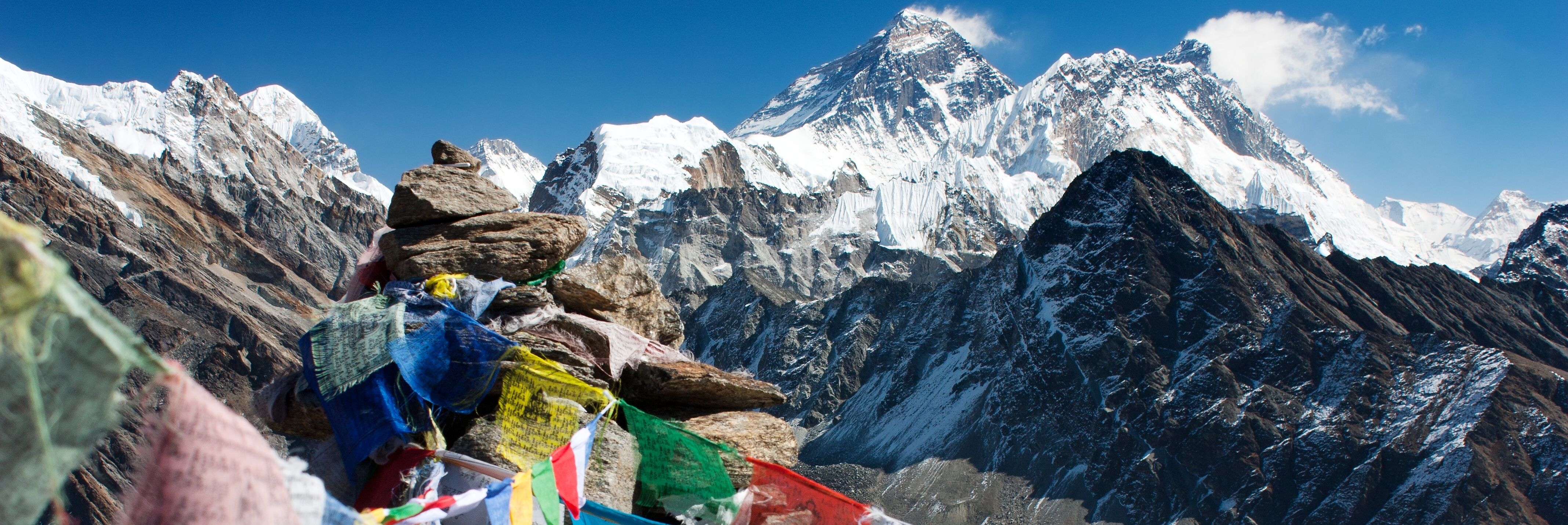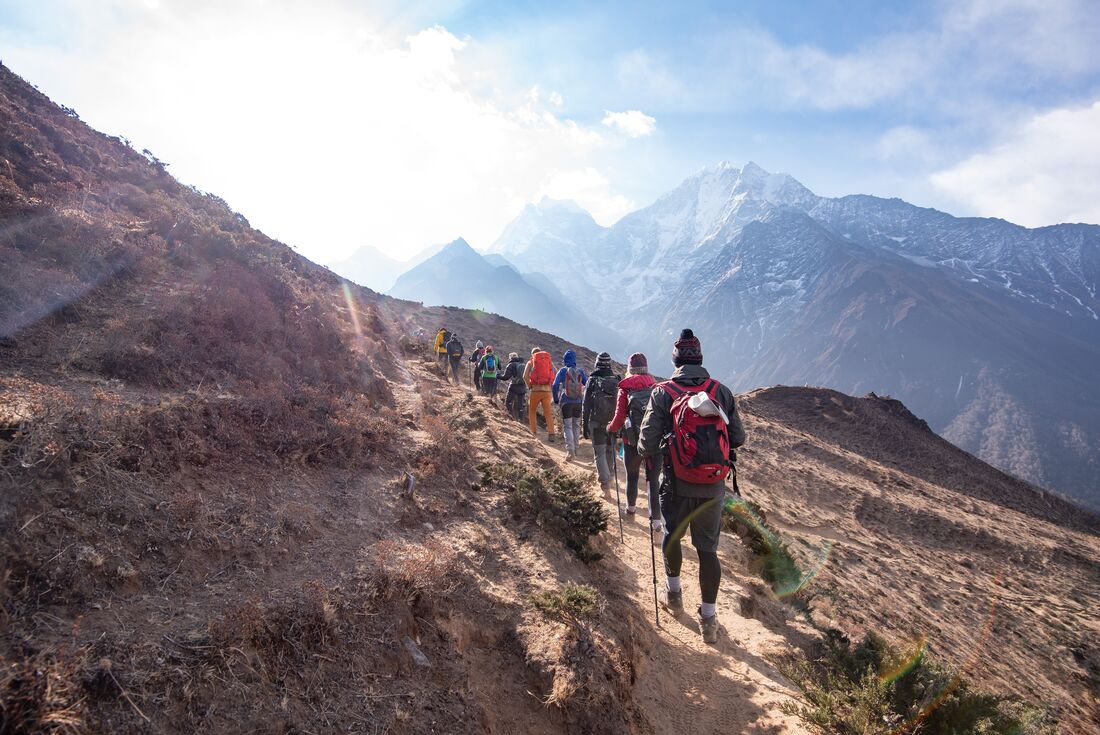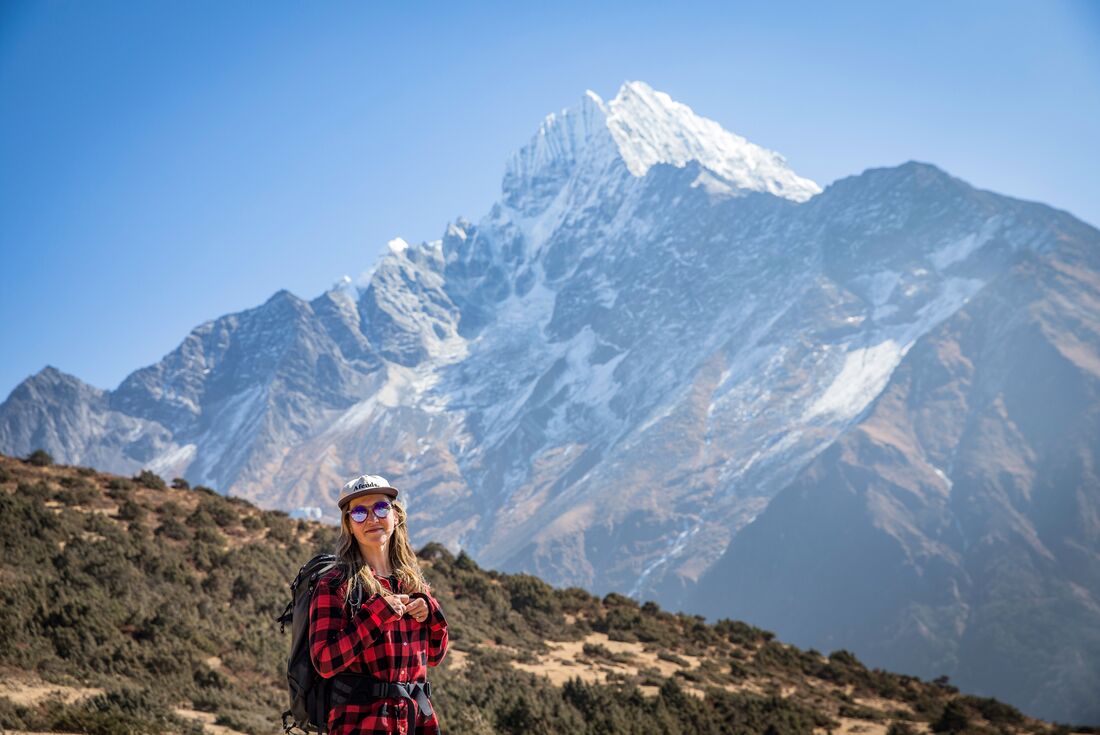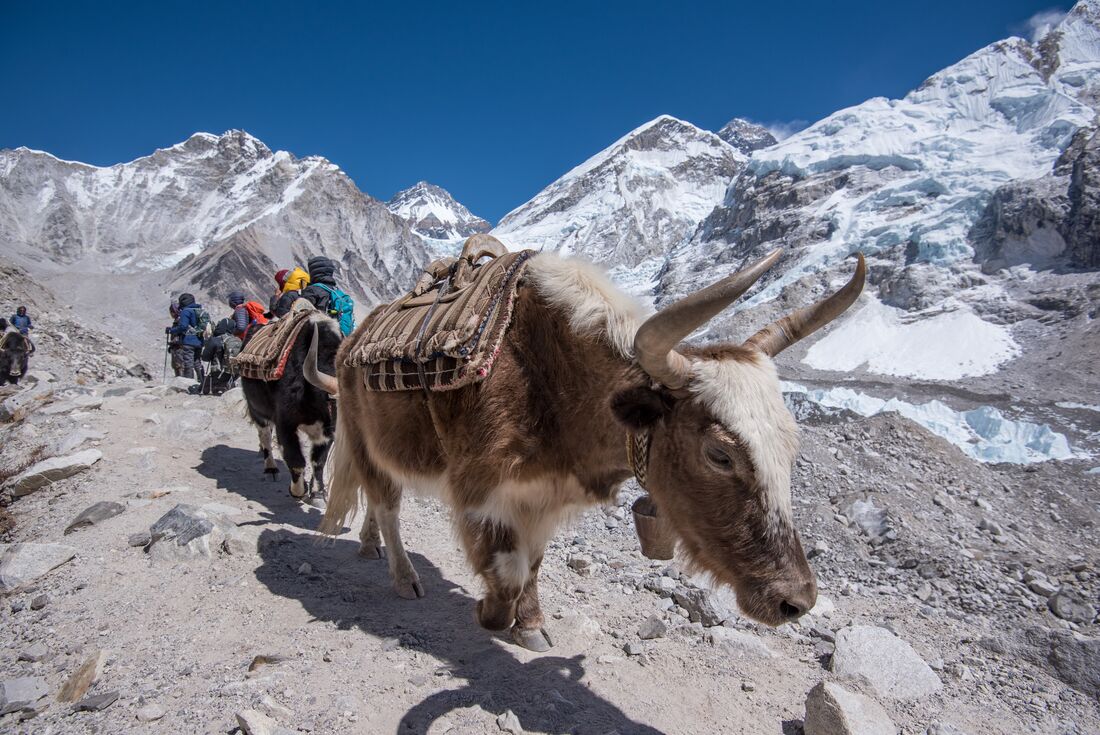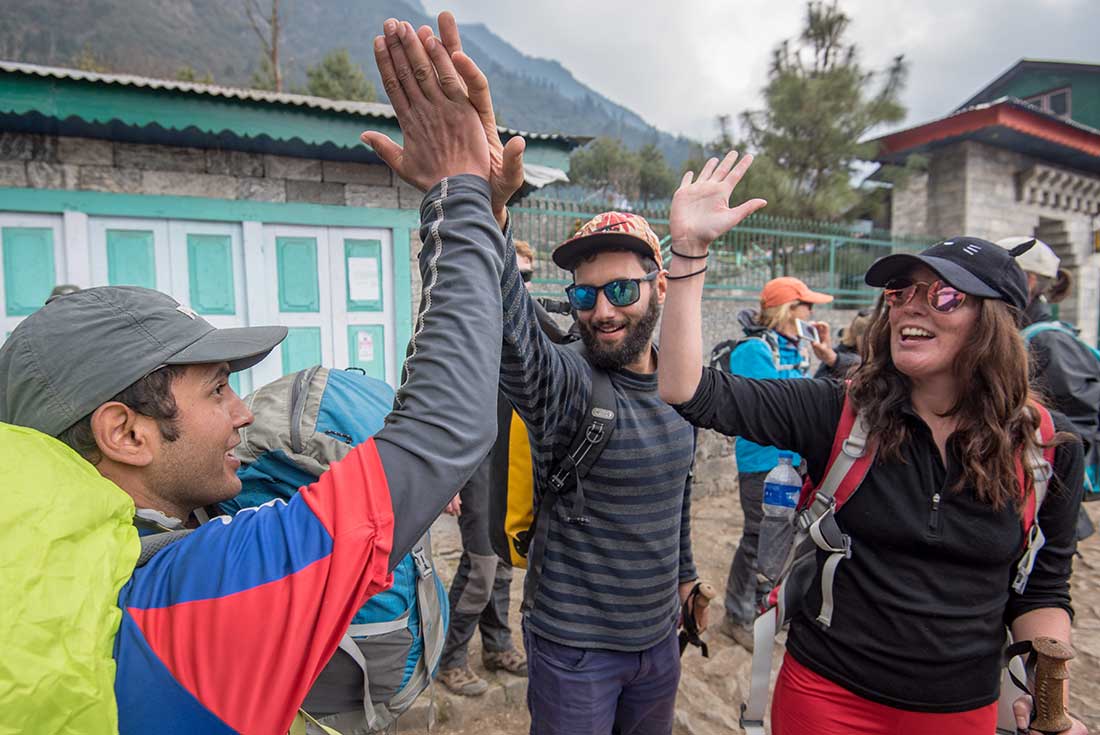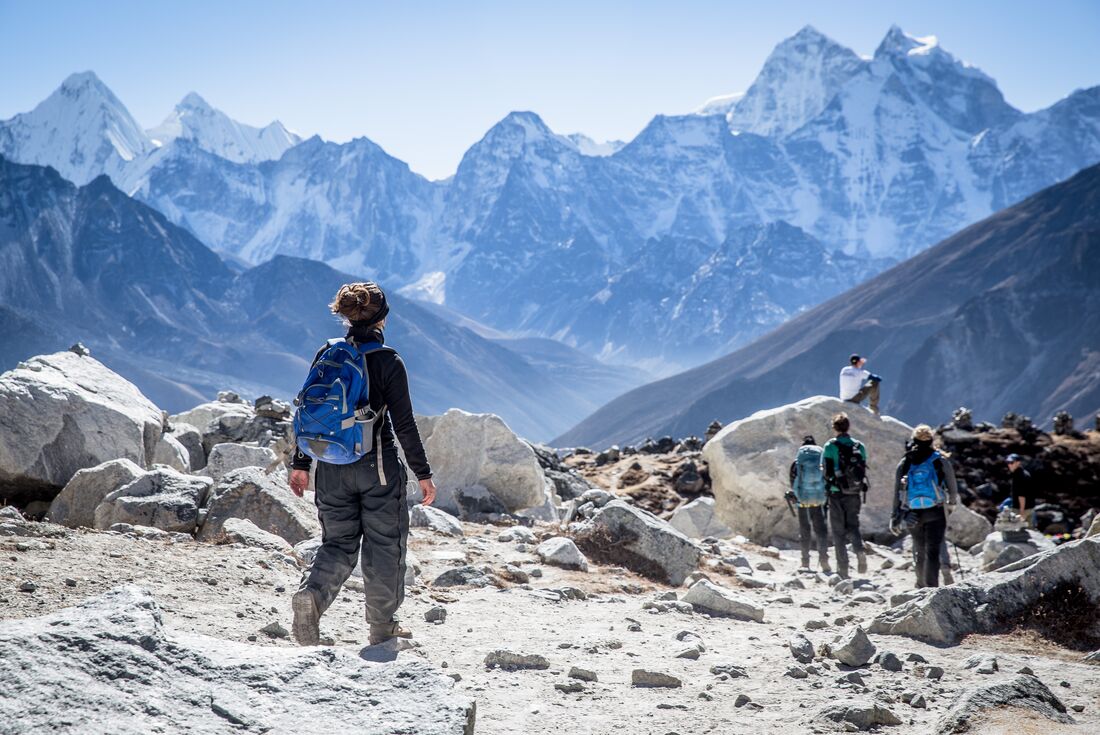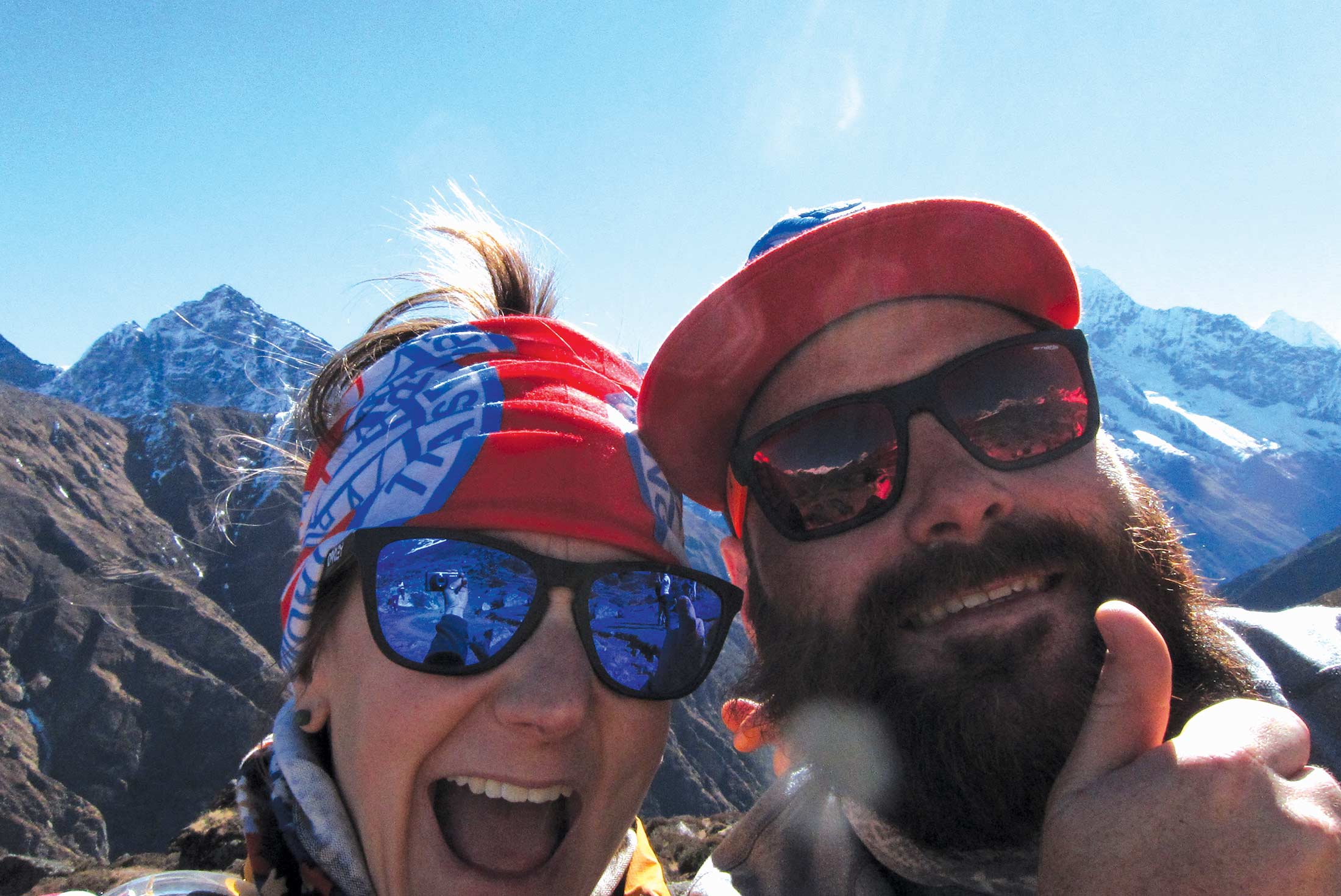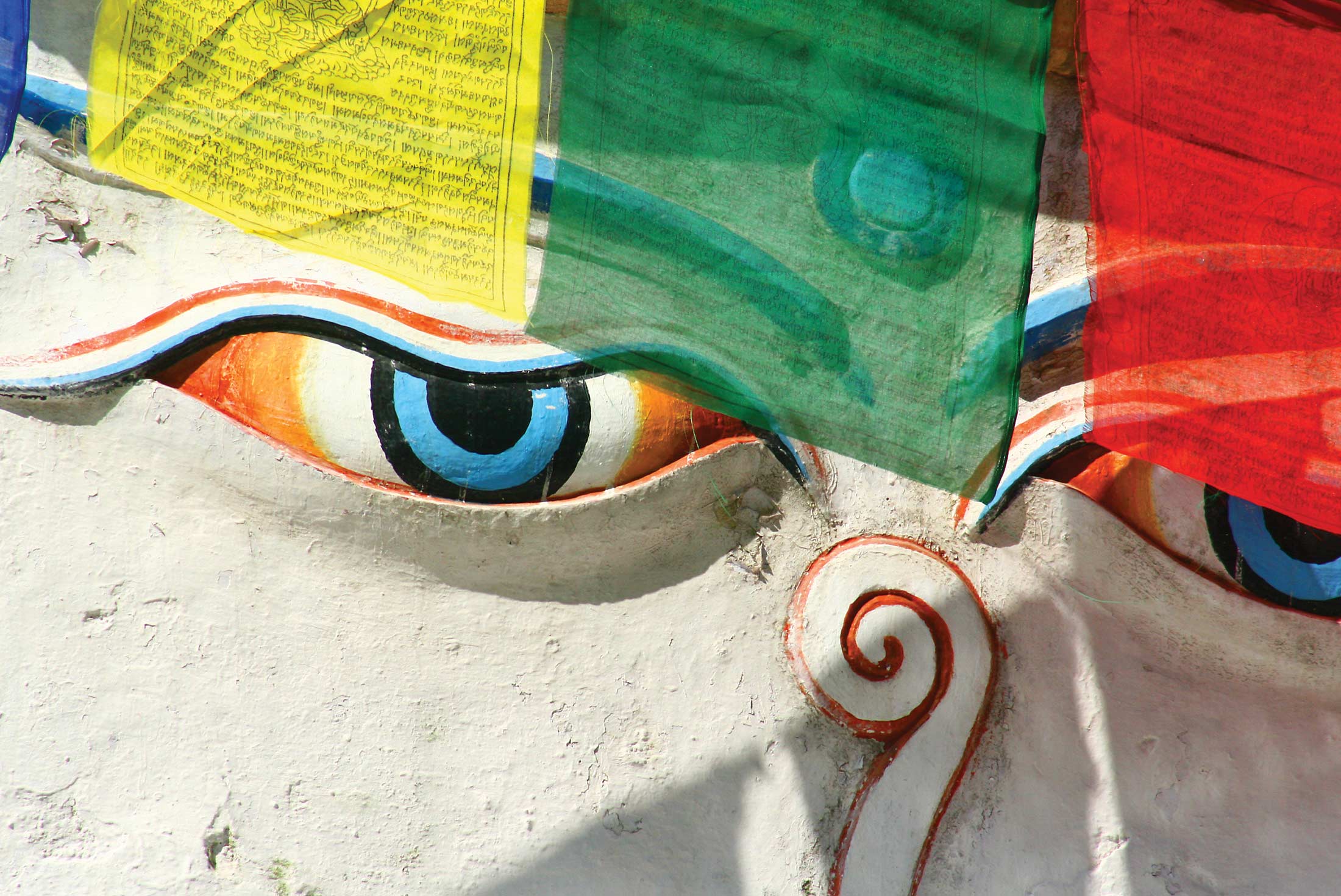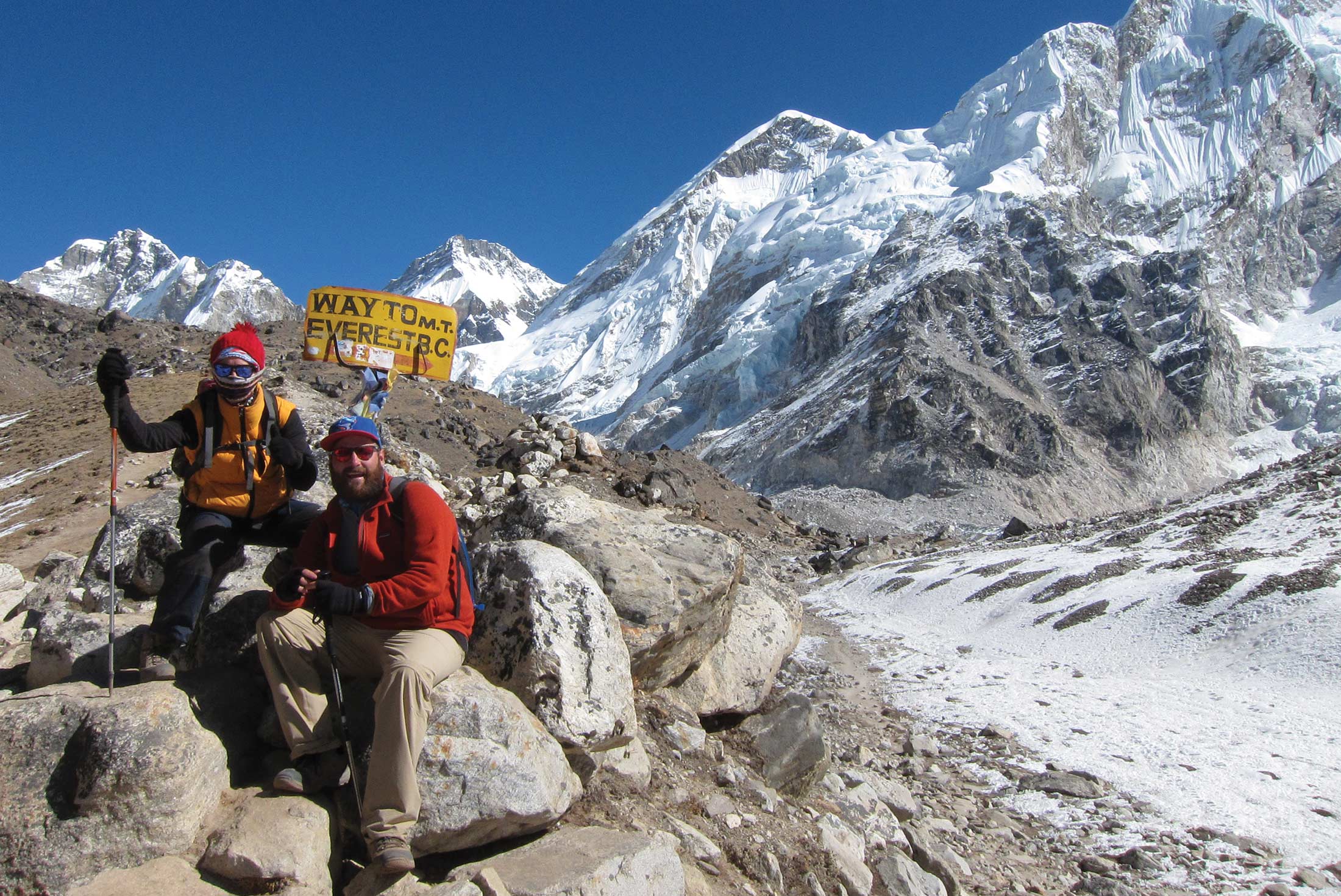- It’s not (just) about the mountains. Hike past everything from alpine lakes and glacial plains to frothy rivers and valleys covered in pink blossoms, depending on the season.
- A Base Camp trek is the bonding experience of a lifetime and this trip gives you the chance to do it with like-minded travellers of a similar age.
- Get your first glimpse of the mighty Himalayan range on the included flight from Kathmandu to Lukla – the famous airport in the sky.
- Hike with an experienced and passionate English-speaking local leader as well as a team of guides and porters who will introduce you to incredible Sherpa culture.
- We partner with local mountaineering and porter welfare programs, so you can trek easier knowing that while our porters are taking care of you, there’s someone looking out for them.
- Read our comprehensive guide on trekking in the Everest region here: https://www.intrepidtravel.com/theme/walking/everest-base-camp-trek
05 Jul 2023
Epic Everest Base Camp Trek
HNYE
Validity: 01 Jan 2023 to 31 Dec 2024
Base. Camp. Two little syllables that conjure up dreams as massive as the Himalayas themselves. This 15-day trekking tour is your chance to make these dreams come true, to challenge yourself and discover both the world’s most famous mountains and your own potential. Walk among giants of nature and leave the Wi-Fi and Netflix behind for card games in tiny teahouses, Sherpa stories and watching the sunrise over Everest. Because group dynamic is crucial on a trek like this, we’ve made a trip just for people who want to hike with other 18 to 29s. Plus, our commitment to the rights and fair treatment of porters and trekking guides means you can hike with a clear conscience knowing you’re doing the trek of a lifetime the ethical way. ALTERNATE ITINERARY: In case of weather conditions leading to cancellations or delays in included flights, this trip will operate on an alternate itinerary. Please see day 1 of the itinerary for more details.
Basix
18 to 29s,Walking & Trekking
Private vehicle,Plane
5
TREKKING AT HIGH ALTITUDES (over 3500m) This trip includes strenuous trekking at altitudes of over 3500m. We take this activity very seriously, which is why we have one of the best safety records for tour operators in this region in our over 30 years of operating treks in the region. You will need to be in great health and have excellent fitness to attempt this trip, as well as be committed to train to ensure you are suitably physically prepared for the challenge. Please have a read of this training manual to help you prepare for your trek. https://www.intrepidtravel.com/sites/intrepid/files/teal/Intrepid_Trekking-Training-Manual.pdf https://www.intrepidtravel.com/au/altitude-sickness
Mandala Heritage Inn
Mandala Street, Thamel
Kathmandu
44600
NEPAL
Phone: +977 15919611
Check In Time is 1400hrs. Transfer can be easily reached to the hotel.
Mandala Heritage Inn
Mandala Street, Thamel
Kathmandu
44600
NEPAL
Phone: +977 15919611
Checkout time is 1200 hrs. Taxis can easily be hired from the street in front of the hotel. We can offer a pre-arranged private transfer service. Inform your agent at the time of booking if you are interested.
1. This trip starts in Kathmandu with an important welcome meeting on day 1 at 4 pm. This allows you extra time to purchase/hire required gear in Kathmandu. 2. Due to the demands of travelling at high altitudes (up to 5545 metres/18192 feet). A Passenger Self Assessment Form is required for this trip. 3. A sleeping bag is required for this trip. Please bring your own or hire one in Kathmandu. 4. A single supplement is available if you’d prefer not to share a room on this trip. The single supplement will only be included on Days 1,14 (Hotel) and is subject to availability. Please speak to your booking agent for further information. 5. Please bring TWO passport sized photos to your joining meeting for your trekking permits. 6. In case of weather conditions leading to cancellations or delays in flights, this trip will operate on an alternate itinerary. Please see day 1 of the itinerary for more details. 7. You must bring an emergency fund of USD 500 in cash with you on this trip, which you may need to use in case of delayed or cancelled flights. 8. If you need assistance booking optional activities pre or post trip, please contact our local operator on +977 980 112 3645. 9. Please be aware that in the event of an emergency evacuation, Intrepid does not have control over which helicopter service may be used. Some helicopters are not in regular use with Intrepid and have not passed our internal safety auditing.
All group trips are accompanied by one of our group leaders. The aim of the group leader is to take the hassle out of your travels and to help you have the best trip possible. Intrepid endeavours to provide the services of an experienced leader however, due to the seasonality of travel, rare situations may arise where your leader is new to a particular region or training other group leaders. Your leader will provide information on the places you are travelling through, offer suggestions for things to do and see, recommend great local eating venues and introduce you to our local friends. While not being guides in the traditional sense, you can expect them to have a broad general knowledge of the places visited on the trip, including historical, cultural, religious, and social aspects. At Intrepid we aim to support local guides who have specialised knowledge of the regions we visit. If you are interested in delving deeper into the local culture at a specific site or location then your leader can recommend a local guide service in most of the main destinations of your trip.
Most national governments provide regularly updated foreign travel advice on safety issues involved with international travel. We recommend that you check your government's advice for their latest travel information before departure and ensure that your travel insurance covers you for all destinations and activities on your trip. Please refer to our website's safety page for links to major travel advisories and updates on safety issues affecting our trips here: https://www.intrepidtravel.com/travel-alerts We strongly recommend the use of a neck wallet or money belt while travelling, for the safe-keeping of your passport, flight tickets, cash and other valuable items. Leave your jewellery at home - you won't need it while travelling. Many of our hotels have safety deposit boxes, which is the most secure way of storing your valuables. A lock is recommended for securing your luggage. Your leader will accompany you on all included activities, however, during your trip you'll have some free time to pursue your own interests or relax and take it easy. While your leader will assist you with the available options in a given location, please note that any optional activities you undertake are not part of your Intrepid itinerary, and Intrepid makes no representations about the safety of the activity or the standard of the operators running them. Please use your own good judgement when selecting an activity in your free time. Please also note that your Leader has the authority to amend or cancel any part of the trip itinerary if it's deemed necessary due to safety concerns. Intrepid's operational safety policies can be viewed on our website at the link below. We recommend that you take a moment to read through this information before travelling, and would appreciate any feedback on how safety is being managed on our trips.
https://www.intrepidtravel.com/safety-guidelines
STRIKES: Demonstrations and protests are common in Nepal, with strikes regularly occurring that may result in curfews or roadblocks being enforced at short notice. At these times, businesses may close and vehicles may not be allowed on the roads. You should avoid any demonstrations or political gatherings and follow local advice, including that of your leader in the event of any disruptions. PETTY THEFT & CRIME: Pickpocketing and other petty theft is common, especially in places where tourists or foreigners frequent. Take care when walking around at night. Avoid walking on your own and don’t carry large sums of cash. Keep valuables in a hotel safe if possible. Bars and restaurants now close at midnight as part of a government crackdown on illegal activities. Foreigners remaining in bars and clubs after hours have been detained by the police. Police have increased their presence in Thamel and Durbar Marg, popular tourist districts in Kathmandu, in an effort to reduce crime in these areas. You should seek out police if you have been robbed or affected by any crime. ALTITUDE: Altitude sickness is a risk, including on the Annapurna, Langtang and Everest Base Camp treks. Please make sure you familiarise yourself with signs and symptoms before you depart and monitor your own health during your trek. INSURANCE: Make sure your insurance covers you for your intended activities, including travel and trekking above 3000m if this is included on your itinerary, mountain rescue services and helicopter evacuation costs. FESTIVALS: Travelling in Nepal during Holi Festival (28-29 March 2021, 27-28 March 2022), can at times be dangerous due to revellers consuming intoxicating substances. The day is often associated with physical violence and danger. Your leader will advise you and your group on what places to avoid on this day and it may even be necessary for us to alter your itinerary for the day to avoid putting you or your group leader in a high-risk situation. Travelling during the Hindu festival Diwali (4 November 2021, 24 November 2022) can also be dangerous. During this time there are many displays of fireworks in the streets. It can be very noisy for several days and there is also a lot of pollution caused by the fireworks. As there are no restrictions on buying fireworks there are often injuries caused by people exploding them inappropriately. During this festival, your leader may be required to alter your itinerary to avoid any dangerous areas to avoid putting the group at risk. INTERNAL FLIGHTS: There have been a number of air accidents in Nepal. We only use airlines that have passed strict safety audits for included internal flights in Nepal, including Buddha Air, Summit Air.
WIFI: Hotels in Kathmandu generally have excellent WiFi connections. Most hotels offer free WiFi in public areas, with some also offering in-room WIFI, sometimes for an additional fee. While trekking WiFi may be available in tea houses and lodges for a small cost. The higher you go the more the use of WiFi and the internet will cost, and likely the slower the speed. Your tour leader will be able to offer some advice on communications in remote areas of the country. Please note that most teahouses do not have electrical outlets in rooms to charge devices but are shared in the main dining area, for an additional fee. Past travellers have found portable solar chargers to be very useful.
PASSPORT You’ll need a valid passport to travel internationally and most countries require your passport to have a minimum of 6 months validity, so remember to check the expiry date. We need your passport information to get everything ready for your trip so it’s important that the information on your booking matches your passport exactly. Please take care to provide the correct details. We recommend carrying a copy of the photo page of your passport while travelling and leaving a copy at home with family or friends. VISAS Many countries require a visa and obtaining the correct visa is your responsibility. We recommend you check your visa requirements as soon as you have booked your trip. This will ensure you have time to prepare your documents and for your visa application to be processed. Entry requirements can change and are different depending on your nationality. Please refer to your government's foreign travel advisories, the consular websites for the countries you’re travelling to and those you may transit through. Always follow visa advice from official websites; not all visa information found online may be valid. You can also head to Intrepid’s Entry & Health requirement page to get the latest information on travel documents and visa requirements, plus local government COVID-19 vaccination and quarantine policies: https://www.intrepidtravel.com/au/visa-health-requirements NEPAL: All foreign nationals (except Indian passport holders) require a visa to enter Nepal. Visas are obtainable from embassies abroad, land borders (including borders with India & Tibet), and on arrival at Kathmandu's Tribhuvan Airport. Please note that visa on arrival is only available to fully vaccinated visitors and those who are not fully vaccinated will require a recommendation letter from a Nepal travel agency and will need to go through 10-day quarantine on arrival. Getting a visa at the airport or land borders can sometimes take time due to long queues. There have been instances when travellers are asked to show proof of exit from the country, ie flight tickets. You may also need to provide two passport photos and the following fees in US dollars (subject to change, cash only). Other currencies are also accepted although rates may differ. The following costs were correct at time of writing: - Multi entry visa valid for 15 days - US$30 - Multi entry visa valid for 30 days - US$50 - Multi entry visa valid for 90 days - US$125 Your visa application form may require you to state the dates on which you enter and exit that country. Please note we suggest you list your date of entry a few days before, and date of exit a few days after your intended dates in case you encounter any delays or problems en route. To help calculate the exact dates of these crossings we have found the website www.timeanddate.com to be very useful. Nepal Covid-19 Entry Requirement For the latest update of what is required in order to enter Nepal, please check your government's foreign travel advice and also visit the following website:https://uploads.mwp.mprod.getusinfo.com/uploads/sites/27/2021/09/nepal-traveler-information-sheet.jpg
It’s not (just) about the mountains. Hike past everything from alpine lakes and glacial plains to frothy rivers and valleys covered in pink blossoms, depending on the season.
A Base Camp trek is the bonding experience of a lifetime and this trip gives you the chance to do it with like-minded travellers of a similar age.
Get your first glimpse of the mighty Himalayan range on the included flight from Kathmandu to Lukla – the famous airport in the sky.
Hike with an experienced and passionate English-speaking local leader as well as a team of guides and porters who will introduce you to incredible Sherpa culture.
We partner with local mountaineering and porter welfare programs, so you can trek easier knowing that while our porters are taking care of you, there’s someone looking out for them.
Read our comprehensive guide on trekking in the Everest region here: https://www.intrepidtravel.com/theme/walking/everest-base-camp-trek
The weather can be unpredictable in the Himalayas and every year a significant number of trips have flights to or from Lukla delayed or cancelled due to weather conditions. See day 1 of the itinerary for the alternative plans should this happen on your trip. Hiking the Himalayas is no walk in the park. But seriously, this trip includes 12 days of trekking for up to eight hours per day, reaching altitudes of over 5500 metres. Depending on the time of year, the weather can be harsh. Ask anyone who has done it and they will say the rewards are worth it, but we can’t stress enough that you must be in excellent health to participate. Think you’re up for it? Find our step-by-step training guide here: https://www.intrepidtravel.com/adventures/trekking-training-guide-tips/. The trekking lodges, known as teahouses, that we stay in on the trek are very simple with only basic facilities. Access to electricity points for charging devices will cost extra. Wi-Fi is available at some locations, but connections may be poor. The scenery and conditions vary between seasons. Please carefully consider the time of the year you wish to trek in and consult this packing guide https://www.intrepidtravel.com/adventures/packing-guide-for-trekking-in-nepal/. This trip includes one or more overnight stays over 3500 metres (11500 ft) where there is a genuine risk of being affected by Acute Mountain Sickness (AMS). If left untreated AMS can be life-threatening. While the vast majority will only feel discomfort, it is not uncommon for a small number of people to need extra care which will be provided by our leaders and local staff. All our trips that spend time at high altitude follow our standard altitude safety measures. A number of medical conditions and medications can also reduce your body's ability to acclimatise, and thus will affect your performance at altitude and make you more susceptible to AMS. If you are worried about any pre-existing condition (e.g. heart problems), or unsure of your physical ability, you must seek medical advice prior to booking. You may also wish to discuss medication such as Diamox that may help aid acclimatisation. Read more about AMS here: https://www.intrepidtravel.com/altitude-sickness
GENERAL HEALTH All travellers need to be in good physical health in order to participate fully on this trip. When selecting your trip please make sure you have read through the itinerary carefully and assess your ability to manage and enjoy our style of travel. Please note that if in the opinion of our group leader or local guide any traveller is unable to complete the itinerary without undue risk to themselves and/or the rest of the group, we reserve the right to exclude them from all or part of a trip without refund. You should consult your doctor for up-to-date medical travel information or for any necessary vaccinations before departure. We recommend that you carry a first aid kit as well as any personal medical requirements in their original packaging as they may not easily be obtained while travelling. COVID-19 The safety and wellbeing of our travellers, leaders, crew, staff, and suppliers continues to remain our highest priority as we travel. You can read more about how we will keep you safe on our trips, including our COVID-19 Health & Safety Guidelines here: https://www.intrepidtravel.com/safe-travels VACCINATION POLICY From 1 January 2023, Intrepid will no longer require travellers to provide proof of vaccination against COVID-19 for this trip. However, we continue to strongly recommend that all travellers get vaccinated to protect themselves and others. Specific proof of testing or vaccination may still be required by your destination or airline. Please ensure you check travel and entry requirements carefully. For more information, including a detailed FAQ about this policy, please visit https://www.intrepidtravel.com/covid19. HEALTH SCREENING If you are unwell prior to travelling, please stay at home and contact us to make alternative arrangements. From 1 January 2023, Intrepid will no longer require travellers to complete a self-screening health form at the group meeting for this trip. If you are displaying any COVID-19 symptoms or have any health concerns during the trip, we will follow the advice of local health authorities to determine whether medical assistance, isolation or further action is required. Travellers who test positive while taking part in an Intrepid trip will need to leave the group for a minimum of five days and may only rejoin the group if presenting as asymptomatic – our team will assist them in arranging a place to self-isolate and any onward journey. It's quite possible that the destination country may have different or more strict protocols than your home country regarding COVID-19. This may include hotel or hospital quarantine or quarantine for the group. Please check your government's travel advice or contact the closest embassies to find out the details. We ask all travellers to continue to monitor their health throughout their travels and report any relevant symptoms to their tour leader. AIR POLLUTION: Air quality in Nepal can be poor, especially in winter. Some towns, including Kathmandu, experience very high levels of seasonal smog and heavy particulate pollution. Seek medical advice if you're concerned about the effects of air pollution. ALTITUDE SICKNESS: Travellers to altitudes higher than 2,500m are at risk of altitude sickness, also known as acute mountain sickness (AMS). This can be life-threatening and affect anyone, even people who are very physically fit. There is a higher risk for those who have had altitude sickness before, who exercise or drink alcohol before adjusting to the altitude, or who have health problems that affect breathing. If your tour travels to high altitude, see your doctor for advice specific to you and your situation before you depart. It is important to be aware of the normal altitude symptoms that you may encounter BUT NOT worry about: - Periods of sleeplessness - Occasional loss of appetite - Vivid, wild dreams at around 2500-3800m in altitude - Unexpected momentary shortness of breath, day and night - Periodic breathing that wakes you occasionally - Blocked nose - Dry cough - Mild headache If you are feeling nauseous, dizzy, or experience other symptoms, please be sure to let your group leader know immediately so that we can monitor your condition. Please be aware that should your group leader deem it unsafe for you to continue trekking at any time, they will arrange for you to descend to a lower altitude. Please read the following document carefully and, during your trip, utilise the table on the back daily to record your own perspective of your general health and any symptoms you may experience: https://www.intrepidtravel.com/altitude-sickness On some days this trip may ascend faster than commonly published recommended ascent rates at altitude. However, based upon an assessment by our external safety and medical advisors, and in conjunction with our own risk assessments, we consider that the ascent rate is acceptable due to the additional safety measures that are in place for our customers. If you have concerns about this, please speak to your booking representative. All our leaders in the Himalayas are trained in the use of a PAC bag (Portable Altitude Chamber) and this is carried on all trips which go above 4,200m. The PAC bag is used in an emergency only to treat altitude sickness in the mountains. A First Aid kit is carried with the group and all our leaders are First Aid trained. Please ensure that your travel insurance policy does cover you up to the maximum altitude on this trip, and includes helicopter evacuation. Please take proof of this with you on the trip, as you will need to show it to the leader. MOSQUITO-BORNE ILLNESSES: Malaria is a risk in some areas of Nepal including Chitwan National Park. Dengue fever and Japanese encephalitis also occur, including on occasion in Kathmandu. Protect yourself against insect bites by wearing adequate protection, including repellent. MEDICAL FACILITIES AND TREATMENT: Medical facilities in Nepal are very limited, particularly outside Kathmandu. In Kathmandu, treatment at international-standard clinics is expensive and up-front payment for services is generally required. Make sure you have adequate travel health insurance and accessible funds to cover the cost of any medical treatment, including evacuation by helicopter.
FOOD IN NEPAL: We do not include meals while trekking, allowing you to choose what you want to eat and when. We know from experience that the altitude and physical exercise can mean trekker's appetites differ quite widely. The menus in the teahouses are varied, ranging from traditional Nepalese dhal bhat to pizza and apple pie. Vegetarians are well catered for in Nepal. How much you need to spend per day will vary, but it could be anything up to US$60 per day for meals, snacks and drinks. Prices tend to get higher the higher you go on trek in response to the difficulty of getting supplies to the teahouses. In Kathmandu and Pokhara there are plenty of restaurants and cafes for all tastes and budgets. For a glimpse at what traditional Nepali cuisine entails, check out our guide here: https://www.intrepidtravel.com/adventures/guide-to-nepali-cuisine/ ALCOHOL & CAFFEINE: Alcohol and trekking don't mix. We highly recommend that you limit your alcohol consumption in Kathmandu prior to your trip. Celebrate your achievements after your trek. Both alcohol and caffeine increase dehydration. Limit your intake of both when hiking at high altitudes.
NEPAL: The official currency of Nepal is the Nepali rupee (NPR). Its symbol is often displayed as Rs. USD is also widely accepted in Nepal. ATMs can only be found in Kathmandu, Pokhara, and Bhaktapur. Make sure you carry sufficient cash to cover your needs when travelling outside of these cities. Money exchange facilities are available in Kathmandu, Namche, Pokhara, Chitwan (only outside the park), and Bhaktapur. Credit cards are not widely accepted. The Government of Nepal has banned the import, export, and use of 500 and 1000 Indian rupee notes in Nepal. You should ensure you are not carrying these notes on arrival in Nepal as they will be confiscated and you may be fined. Please note that most establishments in Asia will not accept foreign currency notes that are old, torn, or faded and they can be very difficult to exchange or extra fees added when exchanging at banks. Please ensure that you have new, clean notes. Before departing on a trek, make sure you have enough Nepalese currency to purchase meals and drinks, in the smaller denominations where possible, as there are no ATMs and larger notes (such as 1000R) can be difficult to change. Nepali Rupee is a blocked currency – it cannot be exchanged into other currencies outside of Nepal. You can only obtain Nepali Rupee in Nepal and must exchange any leftover Nepali Rupee whilst still in Nepal. SPENDING MONEY When it comes to spending money on the trip, every traveller is a little different. You know your spending habits better than we do, so please budget an appropriate amount for things like optional meals, drinks, shopping, optional activities, and laundry. Make sure you have read the itinerary and inclusions thoroughly so you know what is included in the trip price and what you may need to pay for while travelling. CONTINGENCY FUNDS We try to plan for every eventuality, but there are still some things beyond our control. We reserve the right to change an itinerary after departure due to local circumstances or a Force Majeure Event. In such emergency circumstances, the additional cost of any necessary itinerary alterations will be covered by you. Please note we are not responsible for any incidental expenses that may be incurred as a result of the change of itineraries including but not limited to visas, vaccinations or non-refundable flights. Make sure you have access to an extra US$500 for emergencies (e.g. severe weather, natural disasters, civil unrest) or other events that result in unavoidable changes to the itinerary (e.g. transport strikes or cancellations, airport closures). Sometimes these things necessitate last-minute changes to enable our trips to continue to run, and as a result, there may be some extra costs involved. The recommended amount is listed in USD for the relatability of universal travellers, however, local currency may be needed once in the country to cover these costs. As a result of customer feedback, we recommend you allow a figure of between US$500 and US$540 for your food, drinks (including water for the trek) and snacks. In addition you should carry sufficient funds for extra sightseeing and optional activities. On average people spend approximately US$40 on extra sightseeing. Shopping is a personal thing that, again, varies enormously. On average, people spend between US$50 to US$100 on jewellery and other souvenirs. Over the years we have found that many of our travellers find the need for tipping to be both tiresome and embarrassing, especially if they don't have the correct small change. To overcome this, we have established a tipping kitty system. At your group meeting, your tour leader may discuss the idea of running a group tipping kitty, whereby everybody contributes an equal amount and then your tour leader pays the tips while keeping a running record of all monies spent (except restaurant tips). The record can be checked at any time and any money remaining at the end of the tour returned to group members. All our crew (leaders, assistant guides and porters) are provided wages / beneficiaries as per the labor law of Nepal. However, if you are happy with the services provided a tip - though not compulsory - is appropriate. While it may not be customary to you, it is of great significance to the people who will take care of you during your travels, inspires excellent service, and is an entrenched feature of the tourism industry across many of our destinations. We recommend that any tips are given to the intended recipient by a member of your group, rather than collected and passed on by the group leader. The following amounts are based on local considerations and feedback from our past travellers: Hotel porters: NPR 50 is adequate for porters that assist you with bags to your room. Restaurants: Please check the bill and if there’s an addition of 10% service charge, there’s no requirement for tipping. Otherwise 5-10% of the total bill amount is appropriate. Local guides: Throughout your trip you may at times have a local guide in addition to your leader. We suggest US$2-3per person, per day for local guides. (Including city tour guides, jungle guides, rafting guides, assistant trek guides) Porters: Throughout your trip you may at times have a porter in addition to your leader. We suggest US$2-3 per person, per day, per porter. Drivers: You may have a range of drivers on your trip. Some may be with you for a short journey while others may be with you for several days. We would suggest a higher tip for those more involved with the group however a base of US$2-3per person, per day is generally appropriate. Local transport: For a city tour we suggest US$2 per person, per day. Your Group Leader: You may also consider tipping your leader for outstanding service throughout your trip. The amount is entirely a personal preference; however as a guideline US$3-5per person, per day can be used. Of course you are free to tip more or less as you see fit, depending on your perception of service quality and the length of your trip. Remember, a tip is not compulsory and should only be given when you receive excellent service. NOTE: Please don't tip with coins or notes of or less than NPR1NPR 20, or dirty and ripped notes. This is regarded culturally as an insult.
What you need to bring will vary according to when you are travelling. Generally speaking, we recommend you pack as lightly as possible and make sure that you are able to carry and lift your own luggage, and walk with it for short distances. As well as your underwear, toothbrush and other items you always need to pack for travel, below are some items that you specifically need for this trip. Intrepid provide an individual duffel bag to carry your trekking gear. The weight limit per person is 10kg each. Porters carry two bags each as well as a their own backpack. Porters weight limit is 25kg each. Please keep the weight and bulk of your trek bag to a minimum by bringing clothes made from lightweight material. Don't pack too much clothing; one or two changes will be all you need. However, as the weather conditions in the Himalayas are often unpredictable, be prepared for all eventualities, be it rain, unseasonable cold or heat. For the trek all of your gear should be packed into plastic bags to protect it from the weather - dry clothes are essential for your comfort. Your trek leader will assist you in packing your kitbag and can advise what to bring and what can be left behind in Kathmandu. Day pack - Your day pack must have the capacity for the items you will be carrying on a day's walk: rain jacket, spare trousers, warm clothing, water bottles, camera equipment, washing items and other personal effects. A hip/waist strap provides additional comfort. You should consider day packs of at least a 30 to 40 litre capacity. You only need to carry your day pack when trekking each day. SLEEPING BAG & INNER SHEET A good quality, warm sleeping bag is essential while trekking as only blankets are provided at tea houses. Please note that sleeping bags, are readily available to buy or hire in both Kathmandu at very reasonable rates. Your group leader can assist you in hiring gear after your joining meeting. If you plan to hire a sleeping bag we recommend that you bring an inner sleep sheet, which adds another layer of warmth. In winter a thermal inner sleep sheet is warmer. If you bring your own sleeping bag, please think about the time of year of your trek. We recommend a four season bag with a rating to around -10c. In Winter (Dec-Feb) a five seasons bag is recommended. WATER BOTTLES It is essential to bring 2 x 1lt water bottles to refill along the way. While trekking, boiled or safe drinking water is available to purchase in tea houses. However, you should also carry a water purification method. Options include: - purification tablets available from camping stores or pharmacies eg. Micropur. - 2% tincture of iodine, available from pharmacies, used at 4 drops per litre of water and left for at least 20 minutes - longer in very cold weather. ESSENTIAL TREKKING EQUIPMENT Trekking boots (broken in) Gaiters + spikes (for winter departures Dec-Feb only - can be hired in Kathmandu if required) Waterproof 3/4 season jacket and trousers (can be hired/purchased in Kathmandu if required) Camp footwear (ie sneakers, thongs or booties) Several pairs of high quality hiking socks T-Shirts - highly recommended are synthetic t-shirt styles that wick away moisture Thermal underwear/layers Down jacket (can be hired/purchased in Kathmandu if required) Warm mid layers (fleece/micro fibre) Trousers - lightweight, loose fitting, trekking trousers (can be purchased in Kathmandu) Shorts or skirt for summer Tracksuit or fleece pants for even Sleeveless fleece and extra layers for winter departures (Dec-Feb) Warm hat & sun hat Scarf/neck warmer Gloves and mitts - waterproof and warm. Sunglasses with UV protection Head torch (w spare batteries) Sunscreen and lip balm Light weight towel or sarong Personal first aid kit Biodegradable wet wipes/toilet paper Hand sanitizer gel Trail mix/nuts/muesli bars (bring zip lock bags from home) OPTIONAL GEAR Pocket knife Insect repellent Ear plugs Walking poles Extra zip lock bags Hot water bottle (winter months) CASH: Before departing on your trek, make sure you have enough Nepalese currency to purchase meals and drinks during the trek - in the smaller denominations where possible, there are no ATM's and it can be harder to change a NPR1000 note. OTHER GUIDES & FURTHER TRAVEL: For other guides to packing for treks: https://www.intrepidtravel.com/adventures/packing-guide-for-trekking-in-nepal/ If you are spending further time in the region, please see some ideas for regular travelling gear to pack. https://www.intrepidtravel.com/packing-list
For further advice on what to pack, see our Everest Base Camp packing guide here: https://www.intrepidtravel.com/adventures/everest-base-camp-packing-guide/
ALTERNATIVE ITINERARY DUE TO FLIGHT CANCELLATIONS: Weather conditions in the Himalayas can change rapidly, which frequently results in the need for changes to be made to our intended itineraries. Flights throughout Nepal, particularly in high mountain areas, can be delayed or cancelled due to poor weather conditions. Flights between Kathmandu and Lukla are particularly prone to these delays which has the potential to vary the itinerary of all departures in the Everest region. Our contingency plans in case of bad weather preventing the fixed wing aircraft flight from Kathmandu to Lukla are as follows: Day 2 - We will attempt to board our booked fixed wing flight as per the itinerary. If this flight is cancelled we will return to our hotel in Kathmandu for an additional night. Day 3 - We will again attempt to board our booked fixed wing flight. If this flight is cancelled but helicopters are available and permitted to fly to Lukla we will use our best endeavours to charter a helicopter to transport the group. Travellers will need to use their emergency fund to cover the cost of this chartered helicopter. The exact cost will depend on how many travellers are in your group and could be up to US$500. If we reach Lukla on Day 3 by either fixed wing aircraft or helicopter we will then follow the same itinerary to Everest Base Camp, but descend over one less day in order to take our return flight from Lukla on Day 14. Day 4 - If no flights (either plane or helicopter) are possible on the morning of Day 3, then on Day 4 we will travel by road to Phaplu (approximately 9 hours drive by private vehicle) and then trek to Tengboche on the Everest Base Camp route, via Lukla. While we will not be able to reach Base Camp itself on this altered itinerary our travellers have still found it a highly enjoyable trek with superb views of the Everest ranges including Everest itself. We also advise allowing a few extra days in Kathmandu at the end of your trip should your return flights from Lukla be delayed due to weather conditions. SEASONAL INFORMATION: Nepal's climate varies greatly depending on the season: JUN - SEP: the monsoon rains (mostly at night) bring landslides in regional areas. Cloud cover often obscures mountain views with rain, mud, and leeches deterring most trekkers at this time of year. Treks running in September can be hot and very humid at lower altitudes. See what it's like to trek during monsoon here: https://www.intrepidtravel.com/adventures/nepal-during-monsoon-season/ MAR-APR: Spring brings warm weather and spectacular rhododendron blooms. A popular time to visit and one of the peak times to trek. OCT - NOV: Clear skies and warm days make autumn the peak season. DEC - FEB: Winter brings cold temperatures and snow to the mountains. Good trekking, but remember to rug up. Some towns, including Kathmandu, experience very high levels of seasonal smog which can lead to decreased scenic visibility.
We like to think our Intrepid travellers are all connected by a love of adventure and passion for seeing the world in a different way. We've laid down a few non-negotiable rules to ensure everyone feels connected, comfortable and safe on our trips. We ask that you respect your fellow travellers, group leader, and local people and places we visit in all circumstances. We don't tolerate any forms of violence and expect that you follow the local laws, customs and regulations in any destination we travel to. Any behaviour contrary to the above, including any behaviour that prevents our staff from performing their duty of care or continuing the itinerary as planned, may result in travellers being removed from the trip. If you consume alcohol while travelling, we encourage responsible drinking and expect you to abide by local alcohol laws. To ensure the well-being of everyone on the trip, all decisions made by group leaders and ground staff are final. Romantic relationships between travellers and group leaders are not permitted while on trip. By travelling with us, you agree to comply with these rules and the laws and customs of all countries visited. If something is concerning you during your travels with us, please speak to your group leader or local guide immediately. Alternatively, contact us on the emergency contact number detailed in your Essential Trip Information’s Problems and Emergency Contact section.
After your travels, we want to hear from you! We rely on your feedback. We read it carefully. Feedback helps us understand what we are doing well and what we could be doing better. It allows us to make improvements for future travellers. http://www.intrepidtravel.com/feedback/
While we always endeavour to provide the best possible holiday experience, due to the nature of travel and the areas we visit sometimes things can and do go wrong. Should any issue occur while you are on your trip, it is imperative that you discuss this with your group leader or our local representative straight away so that they can do their best to rectify the problem and save any potential negative impact on the rest of your trip. We recognise that there may be times when your group leader/local partner may not be able to resolve a situation to your satisfaction - if this is the case, please ask the leader to speak to their direct manager. You may also choose to provide details in your online feedback, which we ask you to complete within 30 days of the end of your trip. Please do be aware that it is very difficult for us to provide any practical help after the trip is completed, so informing us while still travelling will give us the opportunity to resolve the issue in real-time. For general contact details please use the following page: http://www.intrepidtravel.com/ourtrips/contact/ In case of a genuine crisis or emergency, you can reach our local office on the number below: In the case of a genuine crisis or emergency please contact our office responsible for trips in this region, which is located in Kathmandu: Intrepid’s Local Operator: +977 980 112 3617
Our Responsible Travel Policy outlines our commitment to preserving the environment, supporting local communities, protecting the vulnerable, and giving back to the places we travel. All our trip leaders, suppliers, and staff are trained on these principles and are core to us delivering sustainable, experience-rich travel. Explore the different parts of our Responsible Travel Policy by visiting: https://www.intrepidtravel.com/responsible-travel http://www.intrepidtravel.com/ourtrips/rt/responsibletraveller ELEPHANT PERFORMANCES & ELEPHANT RIDING: While we respect each individual’s decisions while travelling, Intrepid does not include elephant rides or unnatural performance activities on any itinerary, and we recommend you bypass these activities should they be offered to you during your stay. Professional wildlife conservation and animal welfare organisations, including World Animal Protection, advise that contrary to common belief, captive elephants remain wild animals and despite good intentions, unfortunately, many venues are unable to provide the appropriate living conditions elephants require and this ultimately impacts their well-being. While there is some merit in the argument that the money you pay for the activity goes towards keeping the elephants and their mahouts employed, we know that it also fuels demand for elephants to be captured in the wild or captive-bred. We thank you for your support in improving the welfare of these majestic creatures. Further information is available on the below link: http://www.intrepidtravel.com/elephants-welfare PORTERS: Our porters are valued members of our trekking teams. We operate our treks according to standards that provide respectful, safe, and fair working conditions not only in Nepal, but on all our trips globally. For more information on porter welfare, see https://www.intrepidtravel.com/au/porter-policy NEPAL Dress codes are quite relaxed in tourist areas of Kathmandu and Pokhara, but much more conservative in other parts of the country. Remove shoes before entering certain temples and holy places and be aware that non-Hindus may not be permitted at some religious sites. Dress modestly, take care not to offend, and ask your leader if you are unsure if something is appropriate.
We created our not-for-profit, the Intrepid Foundation because you – our travellers – told us you wanted to make an even greater impact in the communities you visit. The Foundation works by teaming up with partners around the world so that together we can deliver greater positive impact at scale. Partners are identified by our local staff who live and work in our destinations. They harness their powerful community connections to determine the issues that matter most and select local partners who can deliver real solutions. Since 2002, the Intrepid Foundation has raised more than 12.8 million dollars and supported more than 130 communities worldwide. Now, with almost 40 partners all over the world, your donations are helping to restore forests in Kenya, empower women in Honduras and promote elephant welfare in Laos, to name just a few. By simply being on this trip, Intrepid Travel will make a donation to the Intrepid Foundation on your behalf. If you choose to donate too, 100% of your donations will go directly to our partners on the ground – where they’re needed most. For more information about the Intrepid Foundation, please ask your leader or visit our website: http://www.theintrepidfoundation.org/ This trip directly supports Seven Women, who are helping to empower marginalised women in Nepal. Widespread gender discrimination means women are often deprived of education, employment opportunities, health care, income and other basic rights. Donations help women become independent and self-sufficient by providing cooking lessons, skills training and educational classes. To find out more or make a donation, visit: www.theintrepidfoundation.org/t/seven-women
TEAHOUSES: Accommodation at local lodges - better known as teahouses - are simple but comfortable. Toilets and washing facilities are shared and rudimentary, and the food is plain and filling. In a teahouse, travellers are provided with small twin share rooms with twin beds, mattresses and pillows. At times, in high seasons, and in places where there are limited number of teahouses, travellers may have to make do with dormitories. In some places, teahouses don't have access to electricity, depending on solar powered lighting instead. In more remote regions, teahouses don't have running water and toilets can mean just a hole in the ground. Hot shower facilities are available in some teahouses for a price but occasionally a hot shower means a bucket of hot water, enough to wash your body. Electricity to charge devices as well as WiFi is usually for an additional fee when available.
LUKLA FLIGHTS Flights going to and from Lukla may be operated out of Ramechhap Airport, in an effort to alleviate congestion at Kathmandu’s Tribhuvan International Airport by the Civil Aviation Authority of Nepal. Lukla is the gateway port to the Everest region and flights throughout Nepal – particularly in high mountain areas – are often delayed or cancelled due to poor weather conditions. In order to maximise our chances of boarding a flight to Lukla, any departures affected will need to wake up quite early on Day 2 to drive the 130 kilometres (approximately 5-hours) from Kathmandu to Ramechhap Airport. A private vehicle transfers will be provided at no additional cost. In addition, flights back from Lukla may also land at Ramechhap Airport, therefore sufficient time is needed for land transport back to Kathmandu. Travellers have on occasion missed international connections as a result of this. Ensure you have adequate travel insurance and contact numbers for your airlines before departure. LUGGAGE LIMITS: Domestic flights in Nepal have strict weight limits - 10kg of check-in luggage and 5kg of carry-on hand luggage per person is included with your flight ticket. Excess baggage (up to 5kg per person only) will be charged at your own expense. TRAVEL BETWEEN KATHMANDU & POKHARA: On itineraries that include road travel between these destinations, past travellers have often decided to fly this route independently to avoid the long overland journey (200km, approx 6+ hours). The flight takes around 35mins. Should you decide to fly, this will be at your own expense with no refunds for road travel available. ROAD TRAVEL: Roadworks and infrastructure projects can cause significant delays on major roads within cities and highways between destinations. Road travel can also be disrupted due to demonstrations and bandhs (strikes) without warning. Major roadworks are currently ongoing in and around Kathmandu and the roads to Chitwan National Park. Delays, heavy traffic, poor road conditions and dust are a reality of road travel in Nepal. MONSOON: The monsoon season is from June to September and weather conditions can disrupt travel during this time due to flooding and landslides. Disruption of air travel and airport closures are also possible. Be prepared that the itinerary may need to change at short notice.
Travel insurance is compulsory on all our trips for those travelling internationally. We require that at a minimum you are covered for medical expenses including emergency repatriation. If you are travelling within your home country or region please confirm before travel that you are entitled to access the public medical system easily should an accident occur. We strongly recommend all travellers have a policy that also covers personal liability, cancellation, curtailment and loss of luggage or personal effects. For international trips, you will not be permitted to join the group until evidence of travel insurance and the insurance company's 24-hour emergency contact number has been sighted by your leader. If you have credit card insurance your group leader will require details of the participating insurer/underwriter, the level of coverage, policy number, and emergency contact number rather than the bank's name and your credit card details. Please contact your bank for these details prior to arriving in-country. For travellers who reside within the European Union, Switzerland or USA the requirement to purchase travel insurance cannot be compulsory. However the purchase of travel insurance is still highly recommended, and travellers from these regions who decline travel insurance when travelling outside of their home region must sign a Travel Insurance Waiver Form at the Group Meeting, recognizing personal responsibility for emergency medical and repatriation costs should they arise. For assistance with travel insurance or other services, please visit the link below: https://www.intrepidtravel.com/booking-resources/our-services
As you travel on a group trip you will be exposed to all the pleasures and maybe some of the frustrations of travelling in a group. Your fellow travellers will probably come from all corners of the world and likely a range of age groups too. We ask you to be understanding of the various needs and preferences of your group - patience with your fellow travellers is sometimes required for the benefit of everyone's travel experience. Remember too that you have responsibilities to the group. If you are requested to be at a place at a certain time, ensure that you don't keep the rest of the group waiting. We have found time and time again that the very best trips we operate are those where the dynamics within the group work well - this takes just a little effort on your part. Due to privacy reasons, we are unable to provide you with contact details and any personal information about your fellow travellers booked on your trip prior to departure. SOLO TRAVELLERS The beauty of our style of travel is that it caters to travellers who are travelling solo and who want to meet and share experiences with like-minded people. On our trips rooming is organised on a twin-share basis. We pair up solo travellers with another traveller of the same gender as per the gender marker on each of their passports. As a responsible tour operator, we strive to create a safe and inclusive environment for everyone. In the case that your gender identity differs from what is indicated on your passport, please contact us so that we can discuss rooming options with you. We also have an optional single supplement available on most trips for travellers who prefer to have their own room. Please note that this only applies to accommodation during the tour. Pre-trip and post-trip accommodation booked through us will be on a single room basis. On a small selection of itineraries some accommodations are booked on an open gender, multi-share basis (for example on a felucca in Egypt or an overnight train in Vietnam). In those instances it will clearly be stated in our Essential Trip Information prior to booking and travelling.
ITINERARY CHANGES Our itineraries are updated regularly throughout the year based on customer feedback and to reflect the current situation in each destination. The information included in this Essential Trip Information may therefore differ from when you first booked your trip. It is important that you review this information prior to travel so that you have the latest updates. Due to weather, local conditions, transport schedules, public holidays, or other factors, further changes may be necessary to your itinerary once in-country. The order and timing of included activities in each location may also vary seasonally to ensure our travellers have the best experience. Your tour leader will keep you up to date with any such changes once on tour. OPTIONAL ACTIVITIES A selection of optional activities that have been popular with past travellers are listed in the day-to-day itinerary. This isn't an exhaustive list and should be used as a guide only for some of what might be available. Prices are approximate, are for entrance only, and don’t include transport to and from the sites or local guides unless indicated. All activities are subject to availability, and maybe on a join-in basis. It may not be possible to do all the activities listed in the time available at each destination, so some pre-planning for what you are most interested in is advised. When it's recommended that travellers pre-book these activities, look for a note in the Special Information section of the day-to-day itinerary. For most, they can either be organised independently on the day, or let your leader know you are interested in the Group Meeting and they can assist. Where activities are considered medium or high risk, we work with operators whose safety and credentials we have sighted and assessed. Although it is possible that you may find the same activity cheaper with another operator on the ground, we cannot vouch for the safety or quality of that operator. Medium and high-risk activities not listed above have not been assessed by us and as such our staff and leaders are unable to assist you with organising these activities. Activities that contravene our Responsible Travel policies are also not listed. Please remember that the decision to partake in any activity not listed is at your own discretion and risk.
Hotel/Guesthouse (2 nights),Tea House/Trekking Lodge (12 nights)

